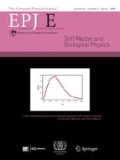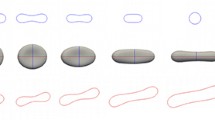Abstract:
We study theoretically vesicle locomotion due to haptotaxis. Haptotaxis is referred to motion induced by an adhesion gradient on a substrate. The problem is solved within a local approximation where a Rayleigh-type dissipation is adopted. The dynamical model is akin to the Rousse model for polymers. An invariant formulation is used to solve a dynamical model which includes a kind of dissipation due to bond breaking/restoring with the substrate. For a stationary situation where the vesicle acquires a constant drift velocity, we formulate the propulsion problem in terms of a nonlinear eigenvalue (the a priori unknown drift velocity) one of Barenblat-Zeldovitch type. A counting argument shows that the velocity belongs to a discrete set. For a relatively tense vesicle, we provide an analytical expression for the drift velocity as a function of relevant parameters. We find good agreement with the full numerical solution. Despite the oversimplification of the model it allows the identification of a relevant quantity, namely the adhesion length, which turns out to be crucial also in the nonlocal model in the presence of hydrodynamics, a situation on which we have recently reported (I. Cantat and C. Misbah, Phys. Rev. Lett. 83, 235 (1999)) and which constitutes the subject of a forthcoming extensive study.
Similar content being viewed by others
Author information
Authors and Affiliations
Additional information
Received 10 February 2000
Rights and permissions
About this article
Cite this article
Cantat, I., Misbah, C. & Saito, Y. Vesicle propulsion in haptotaxis: A local model. Eur. Phys. J. E 3, 403–412 (2000). https://doi.org/10.1007/s101890070011
Issue Date:
DOI: https://doi.org/10.1007/s101890070011




